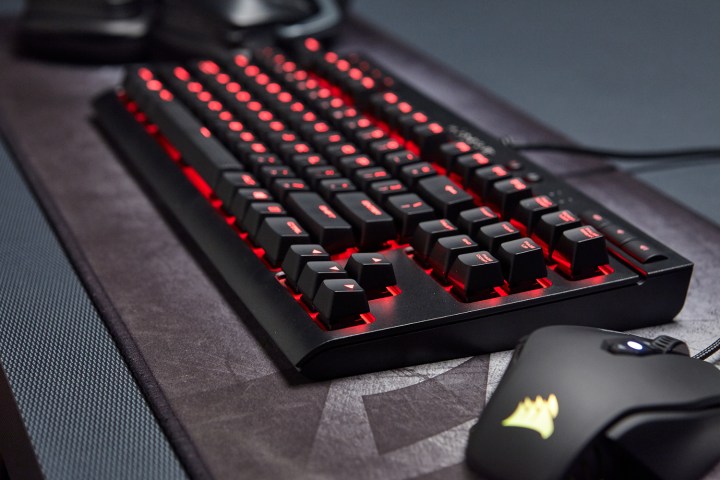
For the uninitiated, the use of Cherry MX switches is important because they are recognized as high-quality, long-lasting switches built for PC gamers. They are sold in different “colors” based on their overall design. For example, the Red switches require very little force to trigger the keystroke, and they’re lightweight as well so that the trip from rest to “actuation” is really quick.
That’s important in a PC gaming keyboard. Another important aspect is backlighting, so that PC gamers have an easier time hunting down the correct key in an instant. In the case of Corsair’s new K63 mechanical keyboard, the company only offers red LED backlighting that is fully customizable for each key through the free Corsair Utility Engine (CUE) tool.
“CUE software also allows for near endless programmability, with every key individually reprogrammable with alternative commands, custom macros or dynamic lighting effects,” Corsair said on Thursday.
Here are the keyboard’s specs:
| Dimensions: | 14.37 x 6.73 x 1.61 inches |
| Weight: | 2.46 pounds |
| Report rate: | Up to 1 millisecond |
| Cable type: | Tangle-free rubber |
| Included media keys: | Mute Volume Up/Down Stop Previous Play/Pause Next |
| LED backlighting color: | Red only |
| Per-key lighting control: | Yes |
| Keycap font size: | Large |
| Compatible Software: | Corsair Utility Engine |
The keyboard promises 100 percent anti-ghosting and full key rollover. The simplest way to explain anti-ghosting is that the metal contacts in a switch create “chatter” before they make the electrical connection that signals a keystroke. While this chatter only lasts milliseconds, this noise can be picked up by the keyboard’s processing chip as multiple presses, aka ghosting. Thus, Corsair’s new keyboard seemingly weeds through the chatter to grab the correct switch connection and send it over to the PC.
Because this is a tenkeyless keyboard, customers won’t see the number pad typically found to the right of the arrow keys. However, as previously stated, Corsair managed to cram media keys at the top of the unit, with the playback control buttons mounted on the left and the audio control buttons on the right. In the center, Corsair placed a Windows Key lock button and a lighting on/off button.
Although the specs state that the USB cord is made of tangle-free rubber, Corsair doesn’t describe the cord’s length. Images also show that the USB cable is permanently attached, which is unfortunate considering Corsair designed this keyboard for portability. By comparison, Logitech’s G Pro keyboard relies on a detachable USB cord so a short isn’t caused in the connection.
Corsair’s new K63 compact mechanical gaming keyboard can be purchased now for $80 by heading here or at participating online/offline retailers.
Editors' Recommendations
- Corsair just stepped up its keyboard game — in a big way
- Corsair relaunches popular gaming keyboard with optical switches
- Corsair’s K65 RGB Mini revitalizes mainstream 60% keyboard goodness
- The Keychron K2 is the mechanical keyboard for Mac I’ve always wanted


